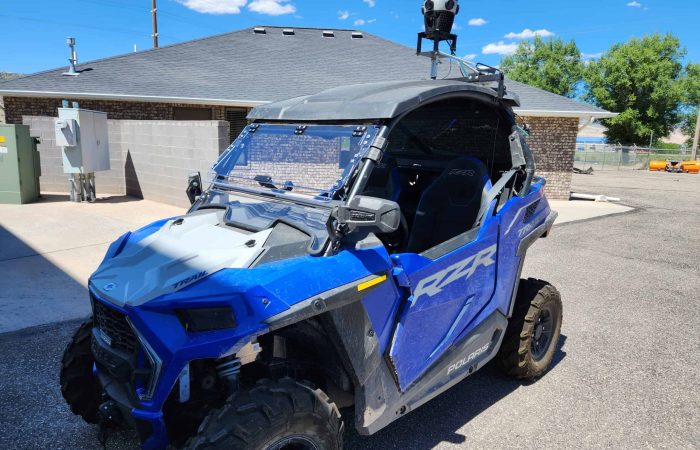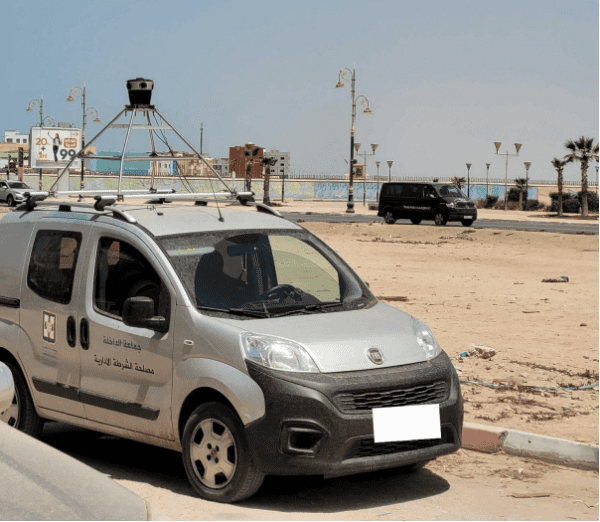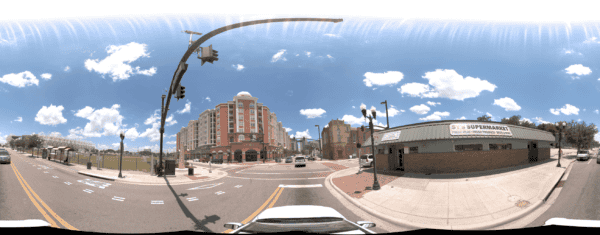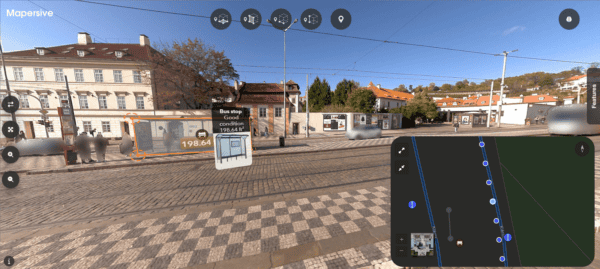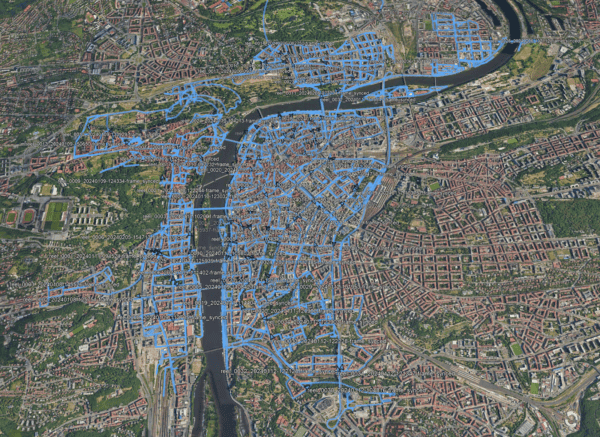And a robust, reliable solution to enable remote site visits with a single device and single operator
Explore the significance of remote site visits in modern times, highlighting the transformative impact of virtual field visits enabled by advanced technologies, and learn:
- Remote site visits enhance safety by eliminating the need for physical presence in hazardous locations and enabling real-time guidance during critical situations.
- Remote visits reduce or eliminate significant costs associated with traditional site visits, promoting cost efficiency and enabling strategic resource allocation.
- Real-time data sharing and collaboration, along with advanced technologies like remote surveys and drones, break down geographical barriers, fostering inclusivity and positioning organizations at the forefront of their industries.

Introduction
Traditional site visit methods are undergoing a significant change in today’s technology-driven era. Remote visits, enabled by virtual platforms and advanced technologies, are revolutionizing various industries.
This shift not only tackles challenges related to physical presence but also offers numerous benefits, including improved safety and substantial cost savings.
Pioneering Remote Site Visits: Insights at GeoWeek 2023
One Mosaic customer, in particular, stands out in exemplifying the advantages of remote site visits—Sandor Laszlo from WGI.
His insights, drawn from the Advanced Visualization and Applications of AR VR XR session at Geo Week 2023, shed light on the remarkable benefits that remote surveys can offer to professionals across different domains.

WGI is a national design and professional services firm leading in technology-based solutions for the construction of public infrastructure and real estate development.
They have been one of our earliest customers and utilize innovative technologies like the Mosaic 51 and Mosaic X cameras, the latter of which is integrated with RIEGL mobile mapping systems, to revolutionize their field operations.
One customer, in particular, stands out in exemplifying the advantages of remote site visits—Sandor Laszlo from WGI. His insights, drawn from an original video and article presented during the Advanced Visualization and Applications of AR VR XR session at Geo Week 2023 on Monday, 13 February 2023, shed light on the remarkable benefits that remote surveys can offer to professionals across different domains.
WGI is an Engineering Design Firm that specializes in geospatial aerial mapping, remote sensing, and photogrammetry markets. At WGI, they are creatively transforming how our world is envisioned, designed, and experienced.
They have been one of our earliest customers and utilize innovative technologies like the Mosaic 51 and Mosaic X cameras, the latter of which is integrated with RIEGL mobile mapping systems, to revolutionize their field operations.
Understanding the Importance of Remote Site Visits
The shift towards remote methodologies marks a significant moment in the way professionals approach their work. The traditional model, involving on-site visits, is not only time-consuming but often poses safety risks and incurs substantial costs.
Remote site visits, on the other hand, leverage the power of technology to transcend these limitations, providing a versatile and efficient alternative.
Redefining the Approach to Site Inspections
One of the primary advantages of remote site visits is the enhanced safety they offer. Eliminating the need for physical presence at potentially hazardous locations, professionals can now conduct inspections from the safety of their offices or homes.
This is particularly crucial in industries such as construction, where site visits may involve exposure to dangerous conditions.
Laszlo emphasizes this point, noting the ability to have an “avatar of the engineer” right next to you. The virtual presence of an expert enables on-the-spot guidance without the need for physical proximity.
This not only safeguards the professionals involved but also optimizes the decision-making process during critical situations.
Reducing Expenses Across the Board
Traditional site visits often entail substantial costs related to travel, accommodation, and permits. Remote site visits revolutionize this aspect by drastically reducing or even eliminating these expenses.
Laszlo highlights the cost-saving benefits by mentioning the ability to “go underneath the point five” and take measurements of pipes and infrastructure, a task that might be challenging or costly in a physical setting.
Moreover, the reduction in travel-related costs extends beyond the obvious. Permits, accommodations, and transportation expenses are minimized, allowing organizations to allocate resources more efficiently.
This newfound cost-efficiency opens up avenues for increased investment in other critical aspects of projects, fostering overall sustainability.
Breaking Down Geographical Barriers
The ability to share real-time data and collaborate seamlessly with team members or clients anywhere in the world is a key advantage of remote site visits. Laszlo illustrates this point by describing how the technology allows individuals to “collaborate and work together” despite being in geographically distant locations.

This global collaboration not only accelerates decision-making processes but also promotes inclusivity in project management. Team members can contribute irrespective of their physical location, fostering a diverse and dynamic work environment.
The breaking down of geographical barriers enhances the overall efficiency and effectiveness of project teams.
Embracing the Power of Innovation
The use of advanced technologies is at the core of successful remote site visits. Laszlo introduces a new use case from WGI, demonstrating the versatility of remote survey technologies.
WGI utilizes remote surveys for measuring trees in areas not easily accessible by traditional methods. Drones are employed to scan these remote locations, allowing teams to collaborate and take measurements simultaneously.
This integration of technology not only enhances existing processes but also opens up new possibilities. The ability to measure trees remotely might seem unrelated to traditional site surveys, but it highlights the adaptability and expansiveness of remote survey technologies.
This innovative approach positions organizations at the forefront of their industries, driving progress and sustainability.
Remote Visits and Surveys Across Industries
Real Estate Virtual Tours
Matterport:
Matterport provides 3D virtual tour technology for real estate listings, allowing potential buyers or renters to explore properties remotely.
Zillow:
Zillow offers virtual tours and immersive 3D walkthroughs for properties listed on their platform, enhancing the online viewing experience for users.
Telemedicine Consultations
Teladoc Health:
Teladoc Health is a leading provider of telemedicine and virtual healthcare services, connecting patients with healthcare providers for remote consultations.
Amwell:
Amwell offers a telehealth platform that enables virtual doctor visits, therapy sessions, and other medical services from the comfort of patients’ homes.
Remote Equipment Inspections in Manufacturing
GE Digital:
GE Digital provides industrial IoT solutions, including remote monitoring and diagnostics for manufacturing equipment, helping companies optimize operations and prevent downtime.
Honeywell Forge:
Honeywell Forge offers connected solutions for industrial operations, including remote asset monitoring and predictive maintenance to improve reliability and efficiency.
Virtual Museums and Cultural Heritage Sites
Google Arts & Culture:
Google Arts & Culture platform partners with museums and cultural institutions worldwide to digitize artworks and artifacts, offering virtual tours and online exhibitions.
The British Museum:
The British Museum in London offers virtual tours of its galleries and collections, allowing people to explore ancient artifacts and cultural treasures from their devices.
Remote Agricultural Surveys with Satellite Imagery
Planet Labs:
Planet Labs operates a constellation of small satellites that capture high-resolution imagery of Earth’s surface, providing farmers and agricultural companies with up-to-date data for monitoring crops and land use.
DroneDeploy:
DroneDeploy offers drone mapping and data analysis software for agriculture, allowing farmers to collect aerial imagery and generate maps for crop health assessment and field management.
The widespread adoption of remote visits and surveys across various industries underscores the versatility and transformative power of advanced technologies.
From real estate virtual tours facilitated by companies like Matterport and Zillow, to telemedicine consultations provided by Teladoc Health and Amwell, the benefits of remote access to services are evident.
In manufacturing, GE Digital and Honeywell Forge offer solutions for remote equipment inspections, while Google Arts & Culture and The British Museum bring cultural experiences to audiences worldwide through virtual tours. In agriculture, Planet Labs and DroneDeploy revolutionize farming practices with remote agricultural surveys using satellite imagery and drones.
These examples highlight how remote visits and surveys are reshaping industries, enhancing accessibility, efficiency, and innovation on a global scale.
Mosaic Camera Systems for Site Inspections
Amid the transformative landscape of remote site surveys, Mosaic Camera Systems emerges as a revolutionary solution, bringing unparalleled capabilities to the table.
Enhanced Precision
Mosaic Camera Systems significantly elevate the precision of remote surveys. Equipped with advanced imaging technologies, these systems provide a detailed and comprehensive view of the surveyed area.
Professionals can unravel hidden details, ensuring a meticulous analysis of structures, landscapes, and underground infrastructures with unprecedented clarity. This enhanced precision not only facilitates accurate measurements but also contributes to more informed decision-making.
Range of Data Capture Capabilities
Mosaic Camera Systems offer a versatile range of data capture capabilities. Whether it’s capturing intricate surface details, these systems adapt seamlessly.
The ability to go beyond surface-level insights, as highlighted by Laszlo, allows professionals to measure surface level structures and infrastructure, providing invaluable data for industries where subterranean elements play a crucial role.
Real-Time Decision Support
Professionals, no matter their geographic location, can access real-time data and collaborate efficiently. This feature aligns with the global collaboration trend, allowing teams to work together, share insights, and make decisions in real-time.
The integration of Mosaic Camera Systems enhances the collaborative efficiency of remote surveys, further accelerating project timelines.
Future-Ready Innovation
Mosaic Camera Systems are designed with a forward-thinking approach, ensuring adaptability to evolving needs. The future potential of Mosaic Camera Systems extends beyond current applications, promising continuous innovation and a proactive stance in meeting the evolving demands of remote site surveys.
Incorporating Mosaic Camera Systems into remote survey methodologies amplifies the benefits of this transformative approach.
The precision, versatility, seamless integration, and future-ready innovation provided by these systems position them as a catalyst for the evolution of remote site surveys across various industries.
As organizations embrace the power of Mosaic Camera Systems, they equip themselves not just with a tool but with a strategic advantage in navigating the future of site inspections and surveys.
Conclusion
In conclusion, the era of remote site visits represents a paradigm shift in how professionals conduct surveys, offering a transformative alternative to traditional on-site methodologies.
The insights shared by Laszlo from WGI highlight the numerous advantages of remote surveys, from enhanced safety and cost efficiency to global collaboration and technological integration.
The case of WGI demonstrates the practical benefits and success stories achievable through the adoption of remote survey technologies.
By going beyond surface-level insights, such as measuring underground infrastructure and trees in remote areas, WGI exemplifies the adaptability and versatility of these technologies.
The introduction of Mosaic Camera Systems further amplifies the transformative potential of remote site surveys. These systems, with their enhanced precision, versatility in data capture, seamless integration with collaborative platforms, and future-ready innovation, position themselves as catalysts for the evolution of remote surveys across various industries.
As we navigate the future of site inspections and surveys, the collective commitment to innovation, collaboration, and the relentless pursuit of excellence becomes imperative. The experiences of pioneers like Laszlo and organizations like WGI inspire us to chart a course for the future—one where the power of technology reshapes our approach to understanding and interacting with the physical world.
In this journey, embracing remote site visits is not just a choice but a necessity for those seeking efficiency, sustainability, and a competitive edge in the ever-evolving landscape of industry practices.
Contact our team today to learn more.

